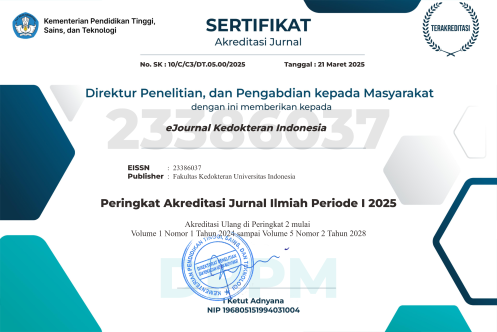Pengaruh Pemberian Ekstrak Plumeria Rubra terhadap Fungsi Ginjal Tikus Model Hiperurisemia
DOI:
https://doi.org/10.23886/ejki.9.27.105Keywords:
kidney function, frangipani flower, hyperuricemia, potassium oxonate, antioxidantsAbstract
Kadar asam urat tinggi dapat meningkatkan stres oksidatif di ginjal yang menyebabkan kerusakan glomerulus dan iskemia tubular. Ekstrak bunga kamboja (Plumeria rubra) mengandung kadar flavonoid tinggi yang dapat mencegah stres oksidatif dan menurunkan kadar asam urat. Penelitian ini bertujuan untuk mengetahui pengaruh pemberian ekstrak P. rubra terhadap fungsi ginjal pada tikus model hiperurisemia. Penelitian dilakukan pada bulan Februari – Maret 2020 di Laboratorium Farmakologi dan Terapi Fakultas Kedokteran Universitas Padjajaran Bandung. Desain penelitian adalah eksperimental menggunakan tikus Rattus novergicus sebanyak 30 ekor yang dibagi dalam 5 kelompok dengan 6 tikus pada masing-masing kelompok. Kelompok kontrol terdiri atas kelompok 1 (kontrol negatif) dan kelompok 2 (kontrol positif dengan alopurinol ), kelompok 3, 4 dan 5 yang masing-masing mendapatkan dosis ekstrak P. rubra 200, 400 dan 600 mg/KgBB/hari. Penelitian dilakukan selama 14 hari dengan intervensi pada minggu pertama berupa induksi dan seminggu selanjutnya perlakuan. Sampel darah diambil melalui ekor tikus untuk menilai kadar asam urat dan kreatinin. Data dianalisis dengan uji Kruskall-Wallis. Hasil yang berbeda bermakna terdapat pada dosis 200, 400 dan 600 mg terhadap kadar asam urat (nilai p=0,004, 0,008 dan 0,004) sedangkan pada kreatinin perbedaan bermakna terdapat pada dosis 200 dan 400 mg (nilai p=0,004 dan 0,042). Terdapat penurunan signifikan pada kadar kreatinin setelah pemberian ekstrak P. rubra 400 mg/KgBB/hari yang berarti dapat memperbaiki fungsi ginjal tikus hiperurisemia.
Kata kunci: fungsi ginjal, P. rubra, hiperurisemia, potasium oksonat dan antioksidan.
The Effect of Plumeria rubra Extract on Kidney Function in Hyperuricemic Rat Model
Abstract
Hyperuricemia can increase oxidative stress in kidney which will cause glomerular damage and tubular ischemia. Frangipani flower extract (Plumeria rubra) contains high amounts of phenols and flavonoids which can prevent the formation of oxidative stress and can reduce uric acid levels. This study aims to determine the effect of frangipani flower extract on kidney function in white rats induced by potassium oxonate. This research was conducted in February – March 2020 at the laboratory of pharmacology and therapy, faculty of medicine, Universitas Padjajaran, Bandung. The design of this study was experimental using 30 Rattus novergicus rats divided into 5 groups with 6 mice in each group. The control group consisted of group 1 (negative control) and group 2 (positive control with alopurinol ). The treatment group consisted of groups 3, 4, and 5, which were variations in doses of P. rubra extract 200, 400, and 600 mg/KgBB /day. The study was conducted for 14 days with the first week of induction and a week later of treatment. Blood samples are taken through the tail to assess uric acid and creatinine levels. The study was analyzed using Kruskall-Wallis. The results of significant differences were found at doses of 200, 400 and 600 mg of uric acid levels (p-value 0.004, 0.008 and 0.004) while the mean creatinine differences were found at doses of 200 and 400 mg (p-values 0.004 and 0.042). In this study, a significant decrease in creatinine levels after treatment showed that there was an effect of P. rubra extract on kidney function with an effective dose of 400 mg/kg/day.
Keywords: kidney function, P. rubra, hyperuricemia, potassium oxonate and antioxidants.
Downloads
Downloads
Published
How to Cite
Issue
Section
License
Copyright (c) 2021 Nahdah Aidah, Muttia Amalia, Tuty Rizkianti

This work is licensed under a Creative Commons Attribution-NonCommercial 4.0 International License.
Accepted 2021-04-29
Published 2021-09-01



